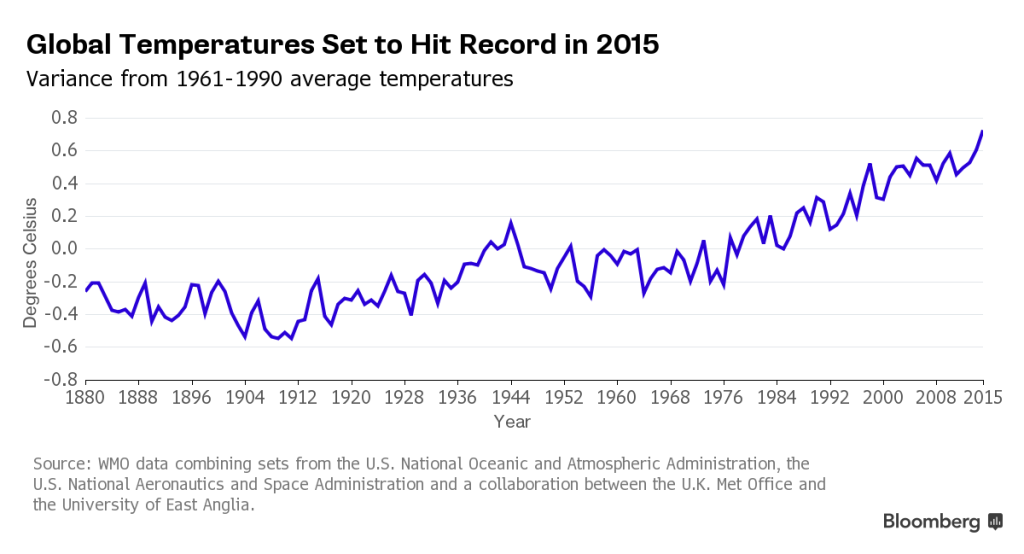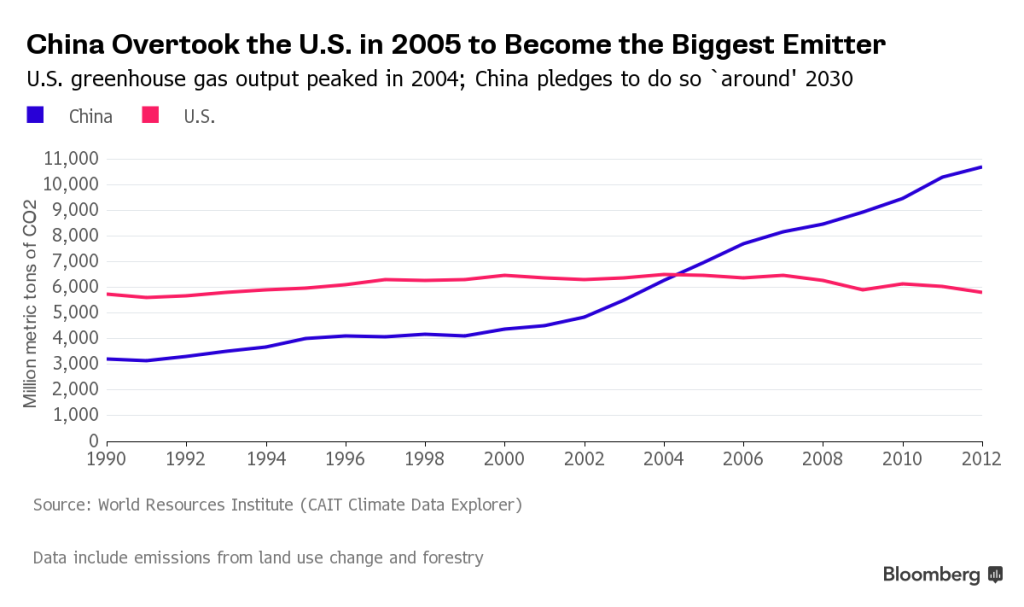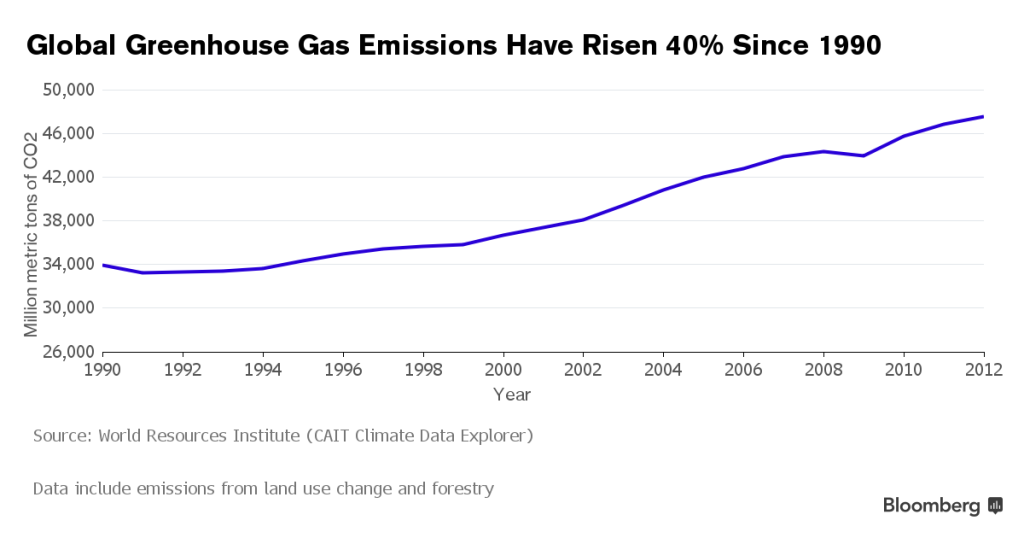Eight Lessons from the Climate Disaster and Why Paris Worked
ENVIRONMENT, 14 Dec 2015
- Envoys from 195 nations labored six years on global accord
- Mouton Cadet wines, Venezuela critic helped the process
13 Dec 2015 – It took years of careful planning by the United Nations and the 195 countries involved to reach the historic deal on climate change agreed in Paris on Saturday [12 Dec].
With so many parties involved in highly technical and political discussions about how to limit emissions from fuels that drive their economies, it’s remarkable anything is ever agreed. The last time envoys attempted such a sweeping deal, the meeting in Copenhagen in 2009 dissolved in finger pointing over who should do what to combat global warming.
 Here are the eight lessons the UN and key delegates involved in brokering the Paris deal learned from Copenhagen that led to the success this year:
Here are the eight lessons the UN and key delegates involved in brokering the Paris deal learned from Copenhagen that led to the success this year:
1) Make it voluntary
The 1997 Kyoto Protocol was a legally binding treaty setting limits for emissions of greenhouse gases — but only for industrial nations. After signing the deal, the U.S. backed out because developing nations had no obligations, leaving Kyoto covering just 37 mostly European nations and 12 percent of global emissions. The Paris deal reaped pledges from 186 nations by making the system essentially voluntary. That meant more were willing to sign up — even the U.S.
The new approach has proven a “game-changer,” Indian Environment Minister Prakash Javadekar said.
2) Prepare the ground
French Foreign Minister Laurent Fabius and his team made more than 100 official visits and held more than 400 bilateral meetings with 140 different countries over the past two years. Half of those meetings were at the level of presidents and prime ministers.
“I’m impressed with Fabius’s leadership,” said International Emissions Trading Association Chief Executive Officer Dirk Forrister, a climate adviser in U.S. President Bill Clinton’s administration. “His sheer presence and seriousness and experience helped to provide some discipline.”
3) The big players need to agree
It’s a deal uniting 195 countries, but the U.S. and China are the most important since they account for 35 percent of emissions. The two countries didn’t coordinate positions in Copenhagen, where China stood with Brazil, India and South Africa in wanting to preserve distinctions in the way the talks deal with rich and poor nations. In 2009, President Barack Obama had to force his way into a meeting of that bloc to have his voice heard. This time, he and Chinese President Xi Jinping came to an agreement in November 2014, spurring other developing nations to join in on taking action.
“The United States has invested enormously in a better dialog with China and the other major economies,” said Global Green Growth Institute Director-General Yvo de Boer, who as UN climate chief in 2009 oversaw the failed talks.
4) Choreography counts
Almost 150 heads of state and government attended the Dec. 1 opening of the summit in the biggest single-day gathering of world leaders in history. Their job? To provide the political momentum — and then get out of the way. In Copenhagen, more than 100 leaders came at the end of the conference, paralyzing the work of lower-level envoys who are experts in the forensics of treaty negotiation.
“All the negotiators had to babysit the ministers and at the same time their heads of state, so they didn’t have any time to spare for the actual negotiations,” Japanese envoy Kuni Shimada said of the 2009 meeting.
5) Atmospherics matter
Logistical snafus in Copenhagen helped poison the atmosphere of the talks. There were long lines to accredit and pass through security, leaving many negotiators standing in the cold while it snowed. The French ensured the little things worked. The food was a notch above previous meetings, with pastries and bottles of Mouton Cadet reserve wine. Water stations were ubiquitous, and the toilets were clean. Shuttle buses ran like clockwork, and public transport was free. During the final days, daybeds came in handy for tired delegates shuffling between round-the-clock sessions.
6) Learn from past approaches
France used the tactics that worked at previous climate conferences. They copied a formula from the meeting in Cancun, Mexico, in 2010 by using pairs of ministers from developed and developing countries to help work through the thorniest topics. They held open informal meetings open to all negotiators called “indabas,” named for a traditional gathering of village elders that South Africa first used with great success in Durban in 2011. And they brought on board Claudia Salerno, one of the envoys who helped sink the Copenhagen deal, to work on a part of the text.
“Engaging former critics is what good diplomacy is all about,” said Paul Bledsoe, a former Clinton adviser.
7) Transparency is essential
In Copenhagen, the Danish presidency that ran the meeting picked a group of countries to work on an accord. The countries left out lost trust in the process, accusing the hosts of drawing up a “secret text.” France was careful to include everyone at each stage — logistically difficult but politically necessary.
“When we’ve seen the presidency straying from the right path, we’ve immediately told them, and they’ve listened and corrected,” said Salerno from Venezuela. In Copenhagen, she called the Danish efforts “a coup d’etat” on the UN charter.
8) Involve business
Companies were given a portal to register their own efforts to slash emissions, making them far more supportive than in Copenhagen. More than 2,400 companies and investors have posted pledges so far. Ultimately, it’s business that will have to deliver many of the emissions cuts and technological solutions to climate change, so involving industry made reaching a deal seem possible or even desirable.
“In Copenhagen business was more bad cop than good cop,” said Ikea Group chief sustainability Officer Steve Howard. “Now it’s more good cop than bad cop.”
Go to Original – bloomberg.com
DISCLAIMER: The statements, views and opinions expressed in pieces republished here are solely those of the authors and do not necessarily represent those of TMS. In accordance with title 17 U.S.C. section 107, this material is distributed without profit to those who have expressed a prior interest in receiving the included information for research and educational purposes. TMS has no affiliation whatsoever with the originator of this article nor is TMS endorsed or sponsored by the originator. “GO TO ORIGINAL” links are provided as a convenience to our readers and allow for verification of authenticity. However, as originating pages are often updated by their originating host sites, the versions posted may not match the versions our readers view when clicking the “GO TO ORIGINAL” links. This site contains copyrighted material the use of which has not always been specifically authorized by the copyright owner. We are making such material available in our efforts to advance understanding of environmental, political, human rights, economic, democracy, scientific, and social justice issues, etc. We believe this constitutes a ‘fair use’ of any such copyrighted material as provided for in section 107 of the US Copyright Law. In accordance with Title 17 U.S.C. Section 107, the material on this site is distributed without profit to those who have expressed a prior interest in receiving the included information for research and educational purposes. For more information go to: http://www.law.cornell.edu/uscode/17/107.shtml. If you wish to use copyrighted material from this site for purposes of your own that go beyond ‘fair use’, you must obtain permission from the copyright owner.

